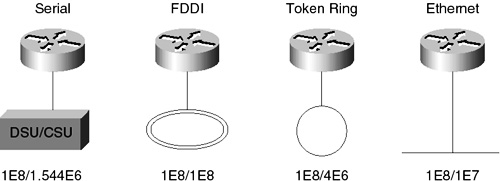Designing Implementing an OSPF Network
Step 1: Analyze the Requirements This step will detail the process of determining expectations and then converting those into a real network or explaining why everyone can’t have video conferencing on the desktop.
Granted, the needs of users are always changing, and sometimes they do not even know what they need. There I said it! However, it is true; they know what they want and when they want it, which is always now or yesterday. Nevertheless, from a network design prospective, they do not always know what they need or why they need it. Nevertheless, you, as the network engineer involved in the design of the network, must still objectively listen and determine user needs. In the end, they are going to be the customers of network, and the customer is always right. You must also take into consideration what the future might hold for them. Therefore, you should ask the users what needs they see themselves having in the future. This question should be directed toward their jobs because it is your responsibility to take their response and turn that into the requirements of the network. A corporate vision is always important. For example, do the long-range corporate plans include having a Web site? If so, what will it be doing? How about running voice over the network? What about video conferencing; is that going to be a corporate need? Additional data you might want to consider gathering is the current organization structure, locations, and flow of information within the organization and any internal or external resources available to you. Armed with this information, your networks need analysis, you should then begin determining the cost and benefit analysis. Of course in many cases you will not be able to get all the equipment or bandwidth you think is necessary. Therefore, it is also advisable to create a risk assessment detailing the potential problems or areas of concern regarding the network design. OSPF Deployment As you go through the process of determining the network requirements, keep in mind some important questions regarding the requirements of OSPF. The answers to these questions will help you further define the requirements of your OSPF network.
Load Balancing with OSPF As you go through the process of determining the network requirements, keep in mind the load balancing feature of OSPF. In the Cisco implementation of OSPF, any router can support up to four equal-cost routes to a destination. When a failure to the destination is recognized, OSPF immediately switches to the remaining paths. OSPF will automatically perform load balancing allow equal-cost paths. The cost associated is determined (default) by the interface bandwidth statement unless otherwise configured to maximize multiple path routing. Before Cisco’s IOS release 10.3, the default cost was calculated by dividing 1,000,000,000 by the default bandwidth of the interface. However, with IOS releases after 10.3, the cost is calculated by dividing 1,000,000,000 by the configured bandwidth of the interface as illustrated in Figure 7-3.
OSPF Convergence OSPF convergence is extremely fast when compared to other protocols; this was one of the main features included within its initial design. To keep this desirable feature fully functional in your network, you need to consider the three components that determine how long it takes for OSPF to converge:
Thus, the average time for OSPF to propagate LSAs and rerun the SPF algorithm is approximately 1 second. Then the SPF delay timer of five seconds must elapse. Therefor OSPF convergence can be a anything from 6 to 46 seconds, depending upon the type of failure, SPF timer settings, size of the network, and size of the LSA database. The worst case scenario is when a link fails but the destination is still reachable via an alternate route, because the 40 second default dead timer will need to expire before the SPF is rerun. Step 2: Develop the Network Topology This step will cover the process of determining the networks physical layout. There are generally only two common design topologies: meshed or hierarchical. The following sections take a look at each to see which is the most efficient design for today’s networks.
Meshed Topology In a meshed structure, the topology is flat and all routers perform essentially the same function, so there is no clear definition of where specific functions are performed. Network expansion tends to proceed in a haphazard, arbitrary manner. This type of topology is not acceptable to the operation of OSPF. It will not correctly support the use of areas or designated routers.
|
EAN: 2147483647
Pages: 200
